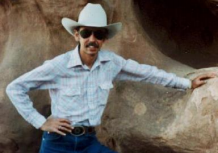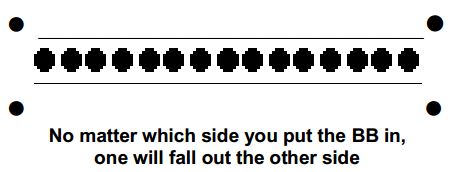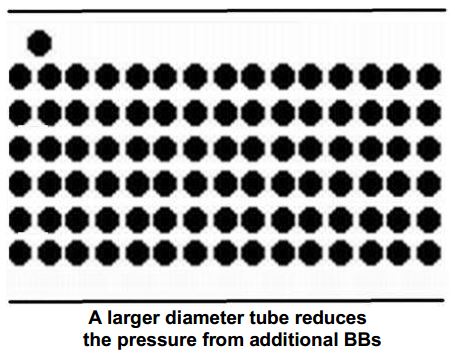How Wires Work Part 2 – Current

[December 2011] We use them every day, but have you ever stopped to think about just how wires do their work in carrying audio or data from one place to another? Curt Flick continues the discussion.
To help better understand what is going on in wires, we introduced some imagery in our first part that we will be using here: the way water flows from a bucket or pipe.
This time we will add to that with an additional image. We are going to use the concept of a string of BBs flowing through a straw or water pipe.

Current
OK, then what is current? Current is the real, physical movement of electrons.
Now this is a very important concept to grasp: there are real particles, called electrons. They have a negative electrical charge. They have mass. And they actually – physically – move. No, they do not move far, but they move fast. Even faster, though, is the movement of their effect!
This concept is fairly easy to visualize. Say we have a long plastic tube, 5/8-inch in diameter. We then fill this tube with ½-inch diameter BBs. It might look something sort of like this:

Now, we push (Voltage) one more ball into one end of the tube. All of the BBs move (current) ½-inch, and the ball at the far end falls out of the tube.

You can do this experiment for yourself. Take a drinking straw and fill it with BBs. Now add one more BB to one end. Not only does one BB fall out the other end but all of the BBs move the distance equal to the diameter of one BB – the one you added.
Relative Speed
We can push quickly or slowly. However, none of the BBs in and of themselves actually moves very far.
They do move at some rate. But the time difference between starting to push the first extra BB into the tube and the last BB beginning to exit the tube, is practically instantaneous.
So it is with electricity. Electrons move, but not far. But their effect can traverse great distances almost instantaneously.
Easy Moves
You might notice that if the inner wall of our tube is very smooth, this movement happens fairly easily.
On the other hand, if the inner wall of the tube is very narrow and/or rough, nearly filled by the BBs, it will take considerably more effort to move the BBs through. This is resistance. Some of the effort pushing the extra BB into the tube will be dissipated by deforming the tube walls in order to make all of the BBs move.

The result is that some of the transfer of power is lost into the resistance within the tube itself.
That resistance can be very small if we have a high conductivity and a smooth and otherwise empty tube. Or it can be great, if the tube is corrugated and firmly holds the BBs in place.
If the tube is made of some very hard material that will not deform to allow the BBs to move at all, we have an insulator. With enough pres-sure and/or voltage, the insulator will break down, and the BBs will move in an uncontrolled fashion, we might call it an arc-over.

So, as we have seen, in its most basic form, a wire is the tube through which the BBs – or the electrons – move.
In an Alternating Current (AC) circuit, the BBs (electrons) move in both directions. It is not too difficult to envision one BB being pushed into the tube, and at the other end the BB that falls out (or one like it) pushed back the other direction.

That is an AC flow. Notice that the BBs in the middle, while constantly moving back and forth a short distance, do scrape against the walls of the tube. But they never really move very far at all!
Obviously, the longer the tube, the more BBs that move a little, and the more BBs that will scrape the walls of the longer tube, using up more energy – which, in turn, becomes power as it is used up and dissipated as friction heat.
This is exactly how and why any wire carrying current warms up – the physical friction of the moving electrons working against the atomic forces attempting to hold them in place.
Wire as Skin
In reality, the surface of our electrical conductor is really a boundary layer, and not really a physical tube or physical barrier at all.
Essentially, it is the atomic forces attempting to hold the conductor in a state of equilibrium that forms our “tube” but a real tube is easier to visualize. If you must, you could magnetize a bunch of BB’s, and lay them out in a line. This would be closer to what we really have, but it would take thousands of them to have any meaningful relationship to the billions of atoms and electrons in a real wire.
Now, suppose we imagine a four-inch diameter “tube,” but still using ½-inch BBs.
The result is less movement at the walls and a lot less scraping as each BB need not move so much to accommodate the addition of an additional BB.
It quickly can be seen that it becomes much, much easier to push extra BBs into the tube, without disturbing any of the BBs already within the tube boundary layer, and with virtually no physical movement at all at the center of this tube. This is known as the “skin effect,” a concept we will discuss further as we go along.
Obviously, the faster we attempt to shove a BB into a tube, the faster the BBs already there must move out of the way to make room. However, this happens much, much easier at the surface of our conductor, where there is no adjacent BB trying to not move. With BBs or electrons, a larger tube or wire heats less from resistance – and a smaller wire heats more.
Inside the Tube
By the way, the further from the surface, the less affect any additional BBs on the surface will have. Pushing additional BBs across the surface will still have the friction as described above, against the BBs already in place, whether a real physical tube exists or not.
Obviously, the larger the existing material, the more surface across which we can move many more BBs in parallel without disturbing the BBs already in place within the material of our wire.
Yes, this does mean our wire gains a slight amount of mass, and gets larger as this happens. Such is skin affect!
The faster we shove in a BB, and return the shove from the far end (remember we are talking AC current here), the relatively easier it is to move BBs (electrons) at the surface, and the more pronounced the skin effect.
In actual practice, some of the BBs move outward, not as much linearly along our tube, into the space above the surface, because it is simply easier than moving the whole mass of BBs along the tube at very high rate, accentuating even more this skin affect, and loss of signal.
High Frequency Effect
At very high rates, very high energy, the movement of the BBs will become almost exclusively at the surface, so at high frequency a hollow tube is just as good a conductor as a solid wire.
The higher the frequency, the more energy it takes – energy, not power – and the more pronounced the affect.
In fact, as the frequency gets high enough, the inside surface of a tube is a completely different conductor than the outside surface of that same tube, but that is beyond the scope of this particular article.
Power
You will recall that power is the energy lost between the energy put into the first BB being pushed into the tube, and the energy that is still present in the last BB pushing it way out of the tube.
To visualize this, let us return to our tube/straw filled with BBs. Stand it vertically. Now push a BB into the bottom of the straw. It will take more effort (more energy) to push a BB into the bottom, raising the whole column of BBs, than it would if the BBs had no mass at all. Some power is lost in simply moving the BB’s, whether they do any work at the far end, or not.
What is available at the far end (or, in this case, the top) is the force applied to the bottom minus the force required to simply move the weight, the mass, of the BBs alone. Once you gain an understanding of why this is happening, you will have a pretty good understanding of the Voltage drop in long, or too small, wires.
However, none of this means much unless we can use these moving BBs, or their affect, to do some useful work. We do exactly this with what we connect to the far end of our wire.
Capacitance and Ground
Before we close out this article let us throw in another concept: that if our source of BBs exists only at one end of the wire.
After we have shoved in all of our BBs we will have none left, and our capacity (in electronic terms, the capacitor) will have been completely discharged. Oops! Not quite.
None of our BBs will move at all, unless there is another BB to take its place.
We need a return conductor of some sort, via some path, to get our BBs (electrons) from the termination site, back to the source. Depending upon what country you are in, you might call this either the ground or earth. That will be our focus in Part 3 as we use grounds to complete circuits, balance them, and shield them.
– – –
Curt “Cowboy” Flick is a broadcast engineer, based in Akron, OH. He is experienced in everything from computers and studio inputs to tower climbing and maintenance. You can contact him at curt@spam-o-matic.com

